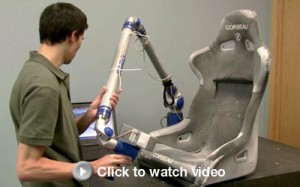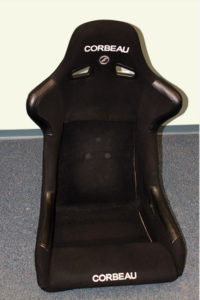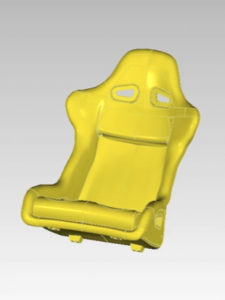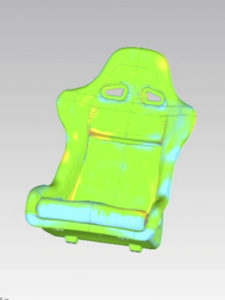 Company: Founded in early 2007 on the West Coast, this high-tech engineering firm has revolutionized the design and manufacture of advanced full-motion personal racing simulation equipment. Its highly specialized products are used not only in professional racing team training and testing environments, but also in private homes, motoring clubs, racing schools, and specialized retail settings. Each simulator is individually assembled, tested, installed, and fully supported.
Company: Founded in early 2007 on the West Coast, this high-tech engineering firm has revolutionized the design and manufacture of advanced full-motion personal racing simulation equipment. Its highly specialized products are used not only in professional racing team training and testing environments, but also in private homes, motoring clubs, racing schools, and specialized retail settings. Each simulator is individually assembled, tested, installed, and fully supported.
Challenge: The company designed a mounting system for a specific racing seat in a new product line. To soundly and safely attach the seat to the high force electromechanical rod-style actuators, high-accuracy locations for the mounting holes were needed, along with lower accuracy scanning requirements for the basic contours on the back of the seat. Normal racing seats attach only to seat rails in a row pattern on the bottom; in the simulator, many more attachments from the upper sides and back of the seat to the actuators are needed to make the movements realistic and convincing. The company must drill these specialized mounting holes through the solid surface of the seat and they must be pinpoint precise. 3D scanning would meet the accuracy requirements.
A secondary reason the company decided to scan the seat was to create a CAD model of the entire simulator assembly which they did not have up until this time. Although the company purchases 80% of their simulator components from industrial suppliers that provided 3D models, the free-form seat model was not so easily obtained from other sources. An added bonus of having the detailed 3D CAD model is that it can be rendered and used in sales presentations and marketing materials.
After the long process of education and deciding to move forward with the scanning project, the results were fantastic,” commented the simulator firm’s owner.”
 Solution: The simulator firm found Laser Design Services Corp. through a Google search. Being a relatively young company and unfamiliar with the 3D scanning world, the owner of the company began a year-long dialog with the Laser Design account manager which culminated in a well conceived and carried out 3D scanning project. “Our Account Manager walked us through the whole process,” the owner commented. “He made it easy to understand the steps involved and eventual outcomes, explaining the time and dollar savings that would accrue.”
Solution: The simulator firm found Laser Design Services Corp. through a Google search. Being a relatively young company and unfamiliar with the 3D scanning world, the owner of the company began a year-long dialog with the Laser Design account manager which culminated in a well conceived and carried out 3D scanning project. “Our Account Manager walked us through the whole process,” the owner commented. “He made it easy to understand the steps involved and eventual outcomes, explaining the time and dollar savings that would accrue.”
Laser Design engineers laser scanned the entire seat, including both the hard shell and the soft seat padding, using the Laser Design FA system with the 10’ Platinum FaroArm® and the SLP-2000 line laser probe along with the 1/8” carbide touch probe for specific landmark features such as the mounting holes. The SLP-2000 offers a super-long 240mm (9.8”) laser line for faster scanning with better coverage than most portable scanning systems on the market today.
The non-contact laser scanning system projects a line of laser light onto all of the part’s surfaces while cameras continuously triangulate the changing distance and profile of the laser line as it sweeps along. Laser scanners measure articles quickly, picking up to 75,000 coordinate points per second, and generate huge numbers of data points without the need for special templates or fixtures. Non-contact scanning means that the problem of missing data on a complex free-form surface is greatly reduced. The system measures fine details so that the object can be exactly replicated digitally.
The same FaroArm setup was used to touch-probe the mounting hole locations on the seat. Rather than having to measure piecemeal by hand, the company’s design team would be able to use the digital model to precisely position mounting components and other features to correctly fit them into the final assembly. Engineers merged the precise touch-probed data with the free-form laser scan data of the rest of the seat for a highly accurate composite model. The accuracy of the laser scanning was ±.005”; the touch probe accuracy was ±.002”.
 The scan reproduced the part profile completely and precisely in the coordinate point cloud. The native software (Surveyor Scan Control) automatically connected the data from multiple views into a common coordinate system in a single 3D scan file. After the scanning was complete, the raw data was processed and refined in Geomagic Studio. The processed data was then modeled into a symmetrical single entity CAD model incorporating design intent. Delivery was promised in 4-5 business days.
The scan reproduced the part profile completely and precisely in the coordinate point cloud. The native software (Surveyor Scan Control) automatically connected the data from multiple views into a common coordinate system in a single 3D scan file. After the scanning was complete, the raw data was processed and refined in Geomagic Studio. The processed data was then modeled into a symmetrical single entity CAD model incorporating design intent. Delivery was promised in 4-5 business days.
Using touch measurement technologies alone to capture the seat’s curved irregular shapes would have taken much longer and produced a much less complete data set. Measurements taken by hand would have been sparser, never really capturing the totality of the shape. Without non-contact laser scanning, this type of exact true-to-life shape replication would be virtually impossible.
Results: Laser Design delivered the highly detailed, accurate CAD model in less that a week’s time. “After the long process of education and deciding to move forward with the scanning project, the results were fantastic,” commented the simulator firm’s owner. A “dumb” solid model with all surfaces and features gave the company a model with spot-on mounting hole locations, and also a complete model of the seat’s complex free-form organic shape that can be used to do motion studies in 3D and for rendering the object to use in product demonstrations as well.
 Laser Design’s scanning, modeling, and delivery process maintained the highest accuracy on the back curvature and mounting locations, and the resulting CAD data was verified and exported to the ideal format the company needed for their assemblies. The owner continued, “At the onset of our talks with Laser Design, the cost of the project seemed expensive because we didn’t understand all the applications of the 3D data. Our Account Manager was very helpful in explaining the process and the uses for the data. Once we had the model, we realized we were able to save huge money because its uses went well beyond our original purpose of creating a CAD model.” In fact, just weeks after receiving the model, the company was contacted by the Discovery Channel to do a segment on their advanced racing simulators for the show “Tech Toys 360.” Since the 3D model was already created, they were able to easily submit a complete and accurately rendered demonstration of the simulator to the producers.
Laser Design’s scanning, modeling, and delivery process maintained the highest accuracy on the back curvature and mounting locations, and the resulting CAD data was verified and exported to the ideal format the company needed for their assemblies. The owner continued, “At the onset of our talks with Laser Design, the cost of the project seemed expensive because we didn’t understand all the applications of the 3D data. Our Account Manager was very helpful in explaining the process and the uses for the data. Once we had the model, we realized we were able to save huge money because its uses went well beyond our original purpose of creating a CAD model.” In fact, just weeks after receiving the model, the company was contacted by the Discovery Channel to do a segment on their advanced racing simulators for the show “Tech Toys 360.” Since the 3D model was already created, they were able to easily submit a complete and accurately rendered demonstration of the simulator to the producers.
“We were very happy with the work Laser Design did for us. Laser Design made the process easy, and they did it right the first time. In the end, we got an extremely versatile deliverable that has saved us a lot of time and money,” the owner concluded.
